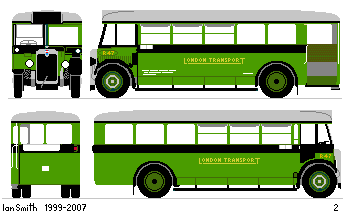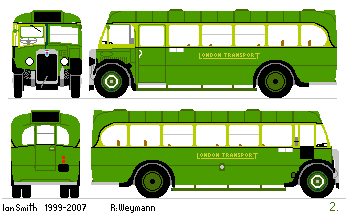
LONDON TRANSPORT R CLASS
AEC Reliance single-deckers
This page prepared by Ian Smith, created 28th July 2007, updated 4th August 2007.
Reliances: R1-R49The Reliance was the start of a new era for AEC, built around a new six-cylinder 6.1 litre engine, giving a substantial boost in performance compared with 1920s types. Performance was good enough to require the development and fitting of front brakes!The East Surrey RelianceEast Surrey No.78 was probably the first Reliance to go into service, in November 1928. It had a rebuilt ADC426 chassis, with the new AEC A130 6.1 litre petrol engine. It went to Reigate, where it was used on the 37 Circular Route. At some stage the front destination blind box was enlarged to allow a route number to be displayed too. It was seen in the newly-enlarged Reigate garage (opened in January 1932), and passed to London General Country Services, but it seems not to have been taken over by LT in July 1933.The LGOC coach Reliances, later R6-R25 The General bought twenty Reliances in May 1929 for their Private Hire business,
fitting them with Chiswick-built semi-saloon bodies. These were of the fashionable kind with
fixed roofs over the front bay and rear, and a foldable canvas roof over the centre section.
They had a main rear nearside door, but exits on both sides at the front. They seated 32.
Livery was the General Private Hire livery. This is variously described as red, with white above the waist,
or green/white or green/cream. I suspect a black roof.
The General bought twenty Reliances in May 1929 for their Private Hire business,
fitting them with Chiswick-built semi-saloon bodies. These were of the fashionable kind with
fixed roofs over the front bay and rear, and a foldable canvas roof over the centre section.
They had a main rear nearside door, but exits on both sides at the front. They seated 32.
Livery was the General Private Hire livery. This is variously described as red, with white above the waist,
or green/white or green/cream. I suspect a black roof.
Late 1929 and early 1930 saw an explosion in the commuter coach business into London, and the General quickly expanded its services. The Reliances were needed for the new Greenline services, and were accordingly fitted with front destination boxes with illuminated GreenLine ads and pressed into service on the new services from Watford to Golders Green and Charing Cross. They were garaged at Leavesden Road, Watford.
Some were sold in 1934, and in late 1935 the remainder lost their original bodies,
receiving instead stylish new Weymann bus bodies. They carried these until 1938,
when the chassis were scrapped and the bodies were translated onto not-much-younger Regals
which became the 11T11 class.
The National bus Reliances, R1-R14, later R45-R49, R26-34 In June and July 1929 General bought fourteen more Reliances,
which it had fitted with shorter Chiswick-built rear entrance bus bodies.
These were on behalf of National, for use on the Watford bus services.
They were numbered R1-R14.
In June and July 1929 General bought fourteen more Reliances,
which it had fitted with shorter Chiswick-built rear entrance bus bodies.
These were on behalf of National, for use on the Watford bus services.
They were numbered R1-R14.
A little later, in October, General started its Watford- Golders Green coach service on an experimental basis, using ten ADC416As with 28-seater semi-saloon bodies from the Hire Department. This service, having sown the seeds of the idea, ceased in November, the coaches presumably not being powerful enough. All ten were then split up, the chassis going to National under bus bodies, and the semi-saloon bodies going onto Reliance chassis. Nine of these came from R6-R14, which became part of the Green Line fleet and were eventually renumbered as R26-R34. These nine were all further rebodied by Weymann in 1935, before withdrawal and surrender of those bodies to 11T11s in 1938.
The extra coach Reliances, R1-R5The pressure for new coaches in 1930 was such that a further five Reliance chassis were built in 1930 to carry 28-seater second-hand bodies from National ADC416s. These became R1-R5 in the Greenline series, completing the rquirement for 34 Private Hire/Green Line Reliances.The Battens coaches, R35-R43In December 1933 London Transport took over the business - and vehicles - of Amalgamated Omnibus Services and Supplies Ltd, more commonly known as Battens. Nine Reliance coaches were in the deal, mostly quite young, dating from 1930 and 1931, with bodywork by Hall Lewis / Park Royal, Clark and Short Bros. London Transport numbered them R35 - R43, and used them as buses or coaches as required until 1938-9. Only one received a Weymann metal body, R40, this being secondhand from R44.The double-deck Reliance, R44 This one really was an oddity. Based on an ADC416A chassis, it was fitted with a Reliance engine
and a lightweight Short Bros open-top double-deck body. It went to East Surrey at Reigate,
and on through ownership by LCGS and London Transport,
with whom it became R44 when the Country bus fleet was numbered.
This one really was an oddity. Based on an ADC416A chassis, it was fitted with a Reliance engine
and a lightweight Short Bros open-top double-deck body. It went to East Surrey at Reigate,
and on through ownership by LCGS and London Transport,
with whom it became R44 when the Country bus fleet was numbered.
In 1935 it was rebodied with one of the Weymann metal bodies, becoming a single-decker. But the odd chassis was still sitting under the new body, and in 1937 the chassis was scrapped, the Weymann body finding a home on one of the Battens coaches (R40) for a year or so.
|
 New Regal T-types took over the Watford services from the Reliances in May 1930.
Back at Brixton Hill, the Reliances found other GreenLine work in the rapidly expanding network,
frequently filling in for the anticipated delivery of Regals, such as on East Surrey's Oxford Circus - Chelsham / Oxted service.
The Green livery with black bands followed from later in 1930, and the two-tone green later.
At some stage they were numbered R6-25, presumably in the Greenline sequences,
and these numbers were retained when London Transport took over in 1933.
New Regal T-types took over the Watford services from the Reliances in May 1930.
Back at Brixton Hill, the Reliances found other GreenLine work in the rapidly expanding network,
frequently filling in for the anticipated delivery of Regals, such as on East Surrey's Oxford Circus - Chelsham / Oxted service.
The Green livery with black bands followed from later in 1930, and the two-tone green later.
At some stage they were numbered R6-25, presumably in the Greenline sequences,
and these numbers were retained when London Transport took over in 1933.
 Ian's Bus Stop
Ian's Bus Stop Reliances: text
Reliances: text bus histories
bus histories